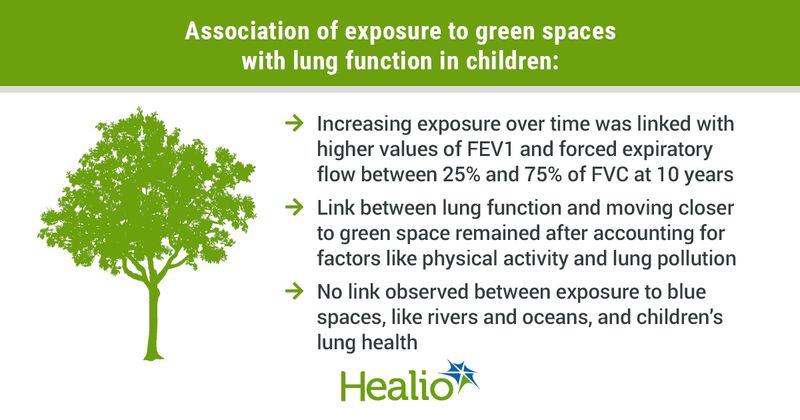Increased exposure to green spaces during childhood could improve lung function
Click Here to Manage Email Alerts
Children with increased exposure to nature during childhood had improved lung function in later life, according to study findings published in European Respiratory Journal.
“We found that living in greener neighborhoods as children grow up is more important for their breathing than living in a green area when they were born,” Diogo Queiroz Almeida, MD, PhD candidate in the department of public health and forensic sciences and medical education at the Institute of Public Health, University of Porto, Portugal, said in a press release. “This may be because babies spend much less time outdoors than children.”

This study utilized data from 3,278 children from the population-based birth cohort, Generation XXI, from the Porto Metropolitan Area in Portugal. Researchers used satellite data and maps to assess the residential normalized difference vegetation index (NDVI) at 100 m, 250 m and 500 m and geographical information systems to assess accessibility to urban green spaces within 400 m to 800 m and the minimum distance to the nearest urban green spaces and nearest blue spaces at birth and age 4, 7 and 10 years. Researchers then calculated measures for averaged exposure, early life exposure and exposure trend over time and used FVC, FEV1 and forced expiratory flow between 25% and 75% of FVC at 10 years as outcomes.
NDVI within 100 m increased from 0.148 at birth to 0.203 at age 10 years. Median distance to the nearest green space also increased from 0.9 km at birth to 0.94 km at age 10 years, and median distance to the nearest blue space ranged from 4.8 km at birth to 4.94 km at age 10 years. Overall, about 18% of children lived within 400 m from an urban green space and 40% lived within 800 m over time.
The researchers found that children whose home surroundings became greener between birth and age 10, either due to a move or environmental changes, had better lung function over time. Increased NDVI exposure over time within 100 m of a child’s residence was associated with high FEV1 (0.0094 L) and forced expiratory flow between 25% and 75% of FVC (0.0201 L/second) in adjusted models.
“Our research suggests the greener, the better. These improvements are modest at around 2%. However, if we look at the whole population, making our neighborhoods greener could have a considerable impact,” Queiroz Almeida said in the release.
Researchers reported no significant associations for the other exposure measures and no mediation effect for pollution or physical activity.
“We looked at factors like physical activity and air pollution, but the link between lung function and moving closer to green space remained, even after we took these into account. It could also be that getting closer to nature reduces stress, which can improve physical health, or it might have a positive effect on children’s microbiome — the community of different bacteria that live in our bodies,” Queiroz Almeida said in the release.
When the researchers evaluated proximity to blue spaces, like rivers or the ocean, they found no link to children’s lung health. However, not many children in this study lived within 800 m of blue space, so further research is required, according to the researchers.
“While the underlying mechanism remains unknown, it brings about additional evidence that city greening may contribute to better respiratory health,” the researchers wrote.
Reference:
- Bringing children closer to nature helps to improve their lung health. Published July 26, 2022. Accessed July 26, 2022.
